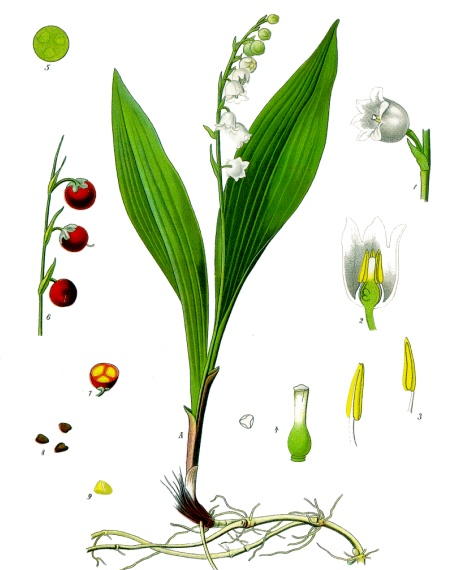
Convallaria majalis (L)

Synonyms: May lily, May bells, Our Lady's tears, Convall-lily, Lily Constancy, ladder-to-Heaven, Jacob's Ladder, male lily, muguet
 Order: Liliaceae
Order: Liliaceae
Description: The leaves of this small herb, arising from a slender creeping rootstock, are 10-15cm long with sheathed stalks; the leafless flowerstems support a one-sided spike of drooping, bell-shaped, white, sweet-scented flowers. It is found in woodlands throughout Europe and Asia from the Mediterranean to the Arctic circle, and is cultivated and naturalised throughout the world.
Parts used: leaves and flowers; the fresh leaves have the most powerful action.
Collection: during the flowering period in May and June.
Constituents: cardioactive glycosides (convallotoxin, convallotoxol, convalloside, convallotoxoloside, convallarin, convallamarin, glucoconvalloside), Saponins (including convallarin and convallaric acid), asparagin, flavonoids, essential oil with farnesol.
Actions: cardioactive, digitalis-like action, diuretic, purgative, emetic
Indications: arrhythmia, congestive heart failure, oedema of cardiac origin, cardiac asthma.
Therapeutics and Pharmacology: Convallaria is a valuable heart remedy with an action similar to Digitalis but without its potential toxic effects. It increases myocardial efficiency and stroke volume without putting extra demands on coronary supply, and reduces excessive irritability of the myocardium. The cardiac glycosides increase the force and power of the heartbeat without increasing the amount of oxygen required by the heart muscle, thereby increasing the efficiency of the heart whilst at the same time steadying excess heartbeats without strain to the heart. The whole plant appears to be more gradual in its effect than isolated digitalis glycosides, it produces comparable effects with a smaller dose. The active cardiac glycosides are released sequentially rather than all together and are readily excreted by the kidneys, thus avoiding toxic buildup. The flavonoids encourage the arteries to dilate while the asparagin acts as a diuretic. Thus Convallaria can be used safely where there is high blood pressure. It may be used in the treatment of heart failure and water retention where this is associated with the heart.
 Combinations: Convallaria may be combined
with Leonurus, Crataegus and
Selenicereus in
heart disease.
Combinations: Convallaria may be combined
with Leonurus, Crataegus and
Selenicereus in
heart disease.
Caution: This herb should be used only under qualified supervision. The Medicines Act (1968) specifically confines the use of Convallaria to practitioners operating under the terms of that Act.
Preparation and Dosage:
Restricted herb; regulatory status P.
Dried leaves: 60-200mg or by infusion
Liquid Extract: 1:1 in 25% alcohol, 0.6-2ml
Tincture: 1:5 in 40% alcohol, 0.5-1ml
Tincture (B.P.C. 1934): 1:8 in 60% alcohol, 0.3-1.2ml
Additional Comments: Culpeper recommended Lily of the valley for strengthening the brain and renovating a weak memory. Mrs. Grieve states that it was used to treat victims of gassing during the First World War. The flowers are used in perfumery. In Chinese medicine, related species are used as a tonic. The red fruits are highly poisonous.
Bibliography
BHMA 1983 British Herbal Pharmacopoeia, BHMA, Bournemouth.
Culpeper, N. 1649 Complete Herbal and English Physician, 1990 reprint of the 1814 London edition of Culpeper’s Complete Herbal, Meyer, Illinois.
Grieve, M. 1931 A Modern Herbal, (ed. C.F. Leyel 1985), London.
Hoffmann, D. 1990 The New Holistic Herbal, Second Edition, Element, Shaftesbury.
Lust, J. 1990 The Herb Book, Bantam, London.
Mabey, R. (ed.) 1991 The Complete New Herbal, Penguin, London.
Mills, S.Y. 1993 The A-Z of Modern Herbalism, Diamond Books, London.
Ody, P. 1993 The Herb Society's Complete Medicinal Herbal, Dorling Kindersley, London.
Polunin, M. and Robbins, C. 1992 The Natural Pharmacy, Dorling Kindersley, London.
Weiss, R.F. 1991 Herbal Medicine, Beaconsfield Arcanum, Beaconsfield.
Wren, R.C. 1988 Potter's New Cyclopaedia of Botanical Drugs and Preparations, C.W.Daniel, Saffron Walden.










